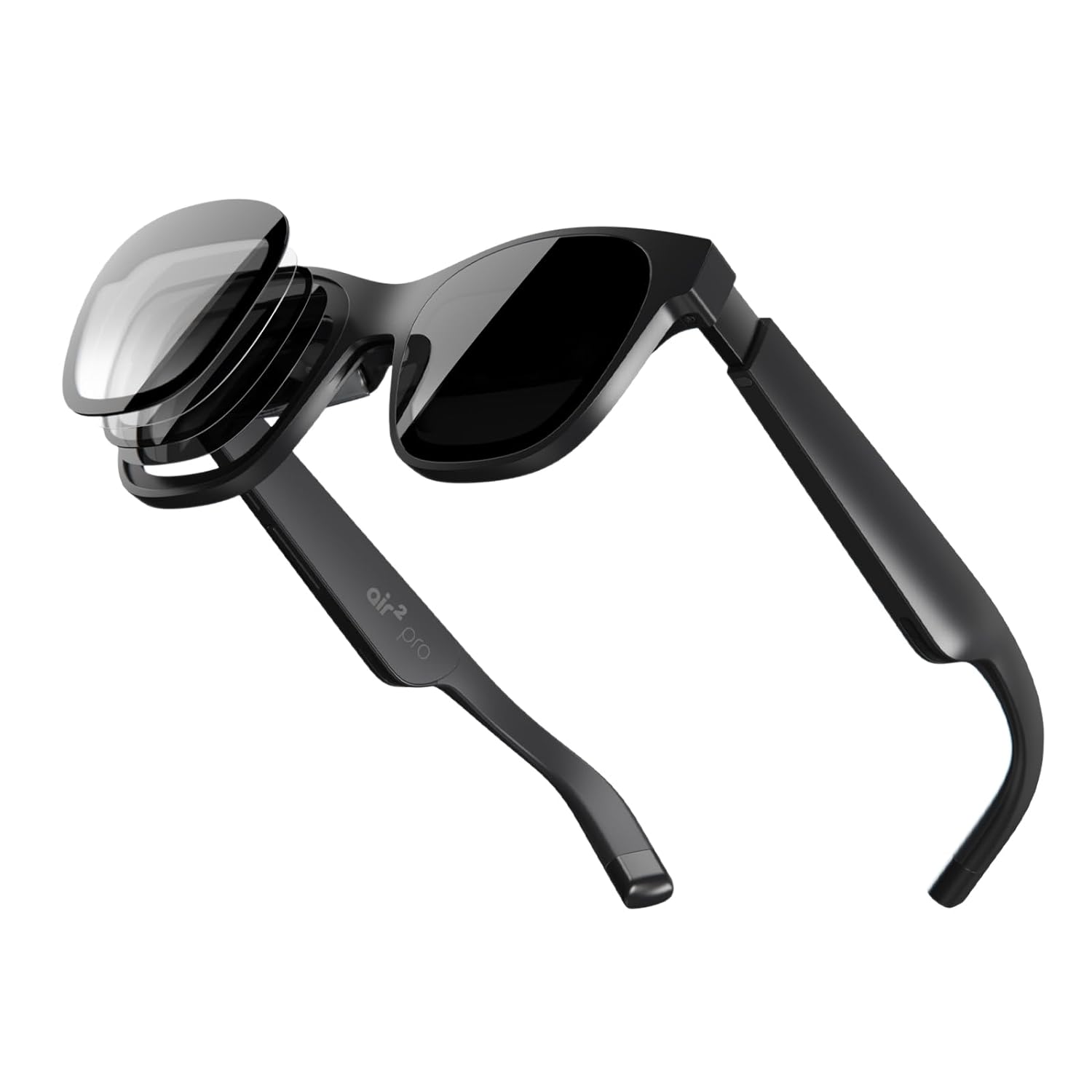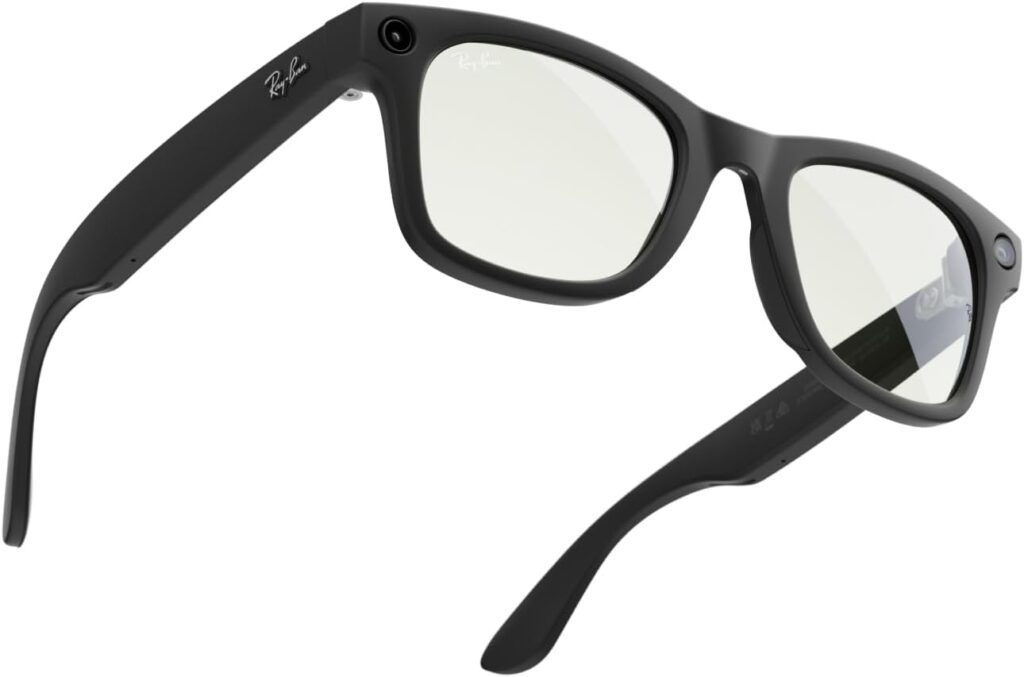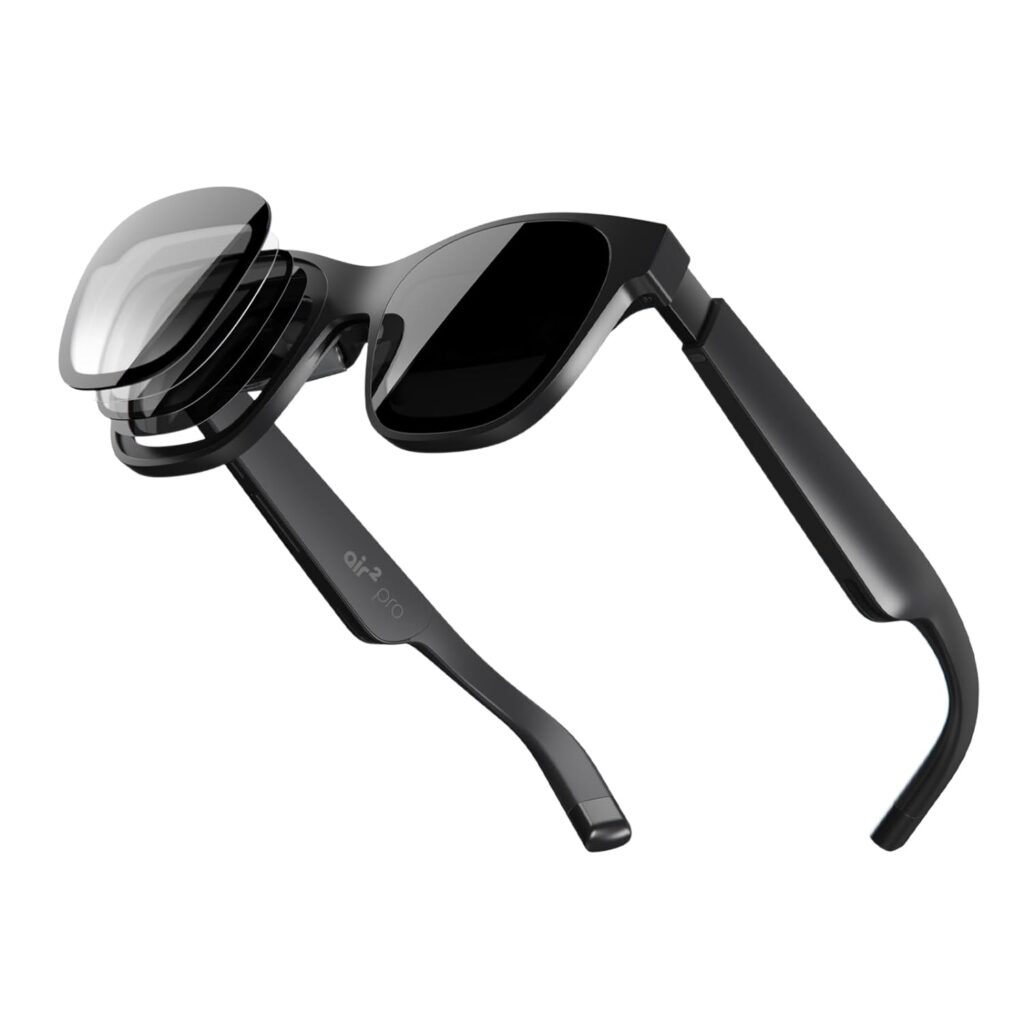
Step into the future with AR glasses, a technological innovation that is revolutionizing the way we experience the world around us. From science fiction to reality, augmented reality glasses have emerged as a game-changer, offering a unique blend of digital information and the physical world.
In this article, we will delve into the power and potential of AR glasses, exploring their capabilities and how they are reshaping various industries. Whether it’s enhancing entertainment experiences, revolutionizing healthcare, or boosting productivity in the workplace, AR glasses have the potential to transform the way we live, work, and interact.
Imagine walking down the street and instantly accessing information about the buildings and landmarks around you. Picture studying anatomy by visualizing a 3D representation of the human body right in front of your eyes. With AR glasses, these scenarios are no longer distant dreams but a tangible reality.
Join us as we delve into the fascinating world of AR glasses and unlock the exciting possibilities they hold. Get ready to witness the future unfold right before your eyes.
How AR Glasses work
AR glasses function by overlaying computer-generated images and information onto the user’s view of the real world. They achieve this by utilizing a combination of cameras, sensors, and displays. The glasses capture the user’s surroundings in real-time, interpret the environment, and then generate and display relevant digital content in the wearer’s field of vision.
At the core of AR glasses are advanced tracking systems that accurately map the user’s physical environment. This allows the glasses to precisely align virtual objects with real-world objects, creating a seamless and immersive augmented reality experience. Additionally, AR glasses often incorporate gesture recognition technology, enabling users to interact with the digital content through hand gestures or voice commands.
The Benefits of AR Glasses
AR glasses offer a multitude of benefits that have the potential to transform various aspects of our lives. One of the key advantages is the ability to provide contextual information and enhance our understanding of the world around us. Imagine wearing AR glasses while exploring a foreign city, and instantly having access to information about historical landmarks, local cuisine, and nearby points of interest. AR glasses have the potential to enrich our experiences and make us more informed and connected individuals.
Another significant benefit of AR glasses is their potential to revolutionize productivity in the workplace. With AR glasses, employees can have important data, instructions, and notifications displayed in their field of vision, allowing for hands-free access to information. This not only improves efficiency but also reduces the need for constant device switching or reliance on physical documents, leading to a more streamlined and productive work environment.
Furthermore, AR glasses can enhance entertainment experiences by blurring the lines between the digital and physical worlds. Imagine watching a live sports event with real-time stats and player information displayed in your glasses, or playing a video game where the virtual characters interact with your real-world surroundings. AR glasses have the potential to take entertainment to a whole new level, creating immersive and interactive experiences like never before.

Industries and Sectors impacted by AR Glasses
AR glasses have the potential to disrupt and reshape various industries and sectors. One of the most notable areas where AR glasses are making an impact is education and training. Traditional teaching methods are often limited by physical resources and the ability to provide hands-on experiences. However, AR glasses can bridge this gap by allowing students to visualize complex concepts, interact with virtual objects, and engage in immersive learning experiences. From virtual field trips to interactive science experiments, AR glasses have the potential to revolutionize education and make learning more engaging and effective.
In the healthcare and medical fields, AR glasses are transforming the way medical professionals diagnose and treat patients. Surgeons can use AR glasses to overlay important patient information, such as medical records or real-time vital signs, directly onto their field of vision during procedures. This enables them to access critical information without having to divert their attention from the patient. AR glasses also have the potential to assist in medical training, allowing students to visualize complex anatomical structures and practice procedures in a realistic virtual environment.
The entertainment and gaming industry is another sector that is being revolutionized by AR glasses. With AR glasses, gamers can experience a whole new level of immersion, as virtual objects and characters seamlessly integrate with their real-world surroundings. Imagine battling virtual monsters in your living room or solving puzzles that are projected onto the walls of your bedroom. AR glasses have the potential to blur the boundaries between the digital and physical worlds, creating unforgettable gaming experiences.
Retail and e-commerce are also being transformed by AR glasses. With the ability to overlay digital information onto physical products, AR glasses can provide customers with detailed product information, reviews, and personalized recommendations while they shop. This not only enhances the shopping experience but also allows retailers to showcase their products in a more engaging and interactive manner. AR glasses have the potential to revolutionize the way we shop, making it a more personalized and immersive experience.
The potential of AR Glasses in Education and Training
AR glasses have the potential to revolutionize education and training by providing immersive and interactive learning experiences. Traditional teaching methods often rely on textbooks, lectures, and static visual aids, which may not fully engage students or cater to different learning styles. However, with AR glasses, students can visualize complex concepts and interact with virtual objects, making learning more engaging and effective.
Imagine studying chemistry by virtually conducting experiments in a virtual laboratory, or exploring ancient civilizations by walking through virtual historical sites. AR glasses can transport students to different times and places, allowing them to have firsthand experiences that would otherwise be impossible. This level of immersion and interactivity can greatly enhance understanding and retention of information.
AR glasses can also assist students with special needs by providing customized learning experiences. For example, students with visual impairments can use AR glasses to access visual information in a way that is tailored to their needs. Similarly, students with hearing impairments can benefit from real-time captions or sign language translations displayed in their AR glasses. By providing inclusive learning experiences, AR glasses have the potential to create a more equitable education system.
Furthermore, AR glasses can facilitate hands-on learning experiences, even when physical resources are limited. For example, students studying anatomy can visualize 3D representations of the human body right in front of their eyes, enabling them to explore and understand complex structures in a more intuitive and immersive way. AR glasses can also simulate real-world scenarios, allowing students to practice problem-solving and decision-making in a safe and controlled environment.
AR glasses have the potential to transform education and training by providing immersive, interactive, and inclusive learning experiences. By bridging the gap between the digital and physical worlds, AR glasses can make learning more engaging, effective, and accessible for students of all ages and abilities.
AR Glasses in Healthcare and Medical fields
AR glasses are revolutionizing the healthcare and medical fields by providing medical professionals with real-time access to critical information during procedures. Surgeons can use AR glasses to overlay patient data, such as medical records or real-time vital signs, directly onto their field of vision. This eliminates the need to divert their attention to physical monitors or documents, allowing them to maintain focus on the patient.
AR glasses can also assist in surgical planning and guidance. Surgeons can use AR glasses to visualize 3D models of patient anatomy, allowing for more accurate preoperative planning and simulation. During surgery, AR glasses can overlay guidance and navigation information onto the surgeon’s field of view, ensuring precise incisions and minimizing the risk of complications.
In addition to surgical applications, AR glasses have the potential to enhance medical training and education. Medical students can use AR glasses to visualize complex anatomical structures and practice procedures in a realistic virtual environment. This allows for hands-on learning experiences without the need for physical cadavers or expensive equipment. AR glasses can also provide real-time guidance and feedback to students, helping them improve their skills and knowledge.
Moreover, AR glasses can assist in telemedicine and remote patient care. Healthcare professionals can use AR glasses to remotely examine patients, visualize medical imaging data, and provide real-time guidance during procedures. This has the potential to improve access to healthcare in remote areas, reduce travel costs and wait times, and enhance the overall patient experience.
AR glasses have the potential to revolutionize the healthcare and medical fields by providing real-time access to critical information, enhancing surgical planning and guidance, improving medical training and education, and facilitating telemedicine and remote patient care. By merging the digital and physical worlds, AR glasses have the power to improve patient outcomes, increase efficiency, and transform the way healthcare is delivered.
AR Glasses in Entertainment and Gaming
AR Glasses are reshaping the entertainment and gaming industry by offering immersive and interactive experiences that blend the virtual and physical worlds. With AR glasses, gamers can see virtual objects and characters seamlessly integrated into their real-world surroundings, creating a whole new level of immersion.
One of the key applications of AR glasses in gaming is location-based augmented reality games. These games utilize the user’s real-world location and surroundings to create unique gameplay experiences. For example, players can explore their neighborhoods and interact with virtual creatures or objects that are superimposed onto their surroundings. This not only adds a layer of excitement and adventure to gaming but also encourages physical activity and exploration.
AR glasses also have the potential to revolutionize traditional board games and card games by adding digital elements and interactivity. Imagine playing a game of chess where the pieces come to life and interact with each other, or playing a card game where the cards display animations and special effects. AR glasses can enhance the social aspect of gaming by allowing players to see each other’s virtual avatars and interact in a shared virtual space.
Furthermore, AR glasses can bring virtual characters and objects into the real world, allowing users to interact with them in a more realistic and tangible way. For example, users can have virtual pets that respond to their gestures and voice commands, or they can play virtual instruments that respond to their movements. This level of immersion and interactivity blurs the boundaries between the digital and physical worlds, creating unforgettable gaming experiences.
AR glasses have the potential to transform the entertainment and gaming industry by providing immersive and interactive experiences that merge the virtual and physical worlds. From location-based games to enhanced board games and interactive virtual characters, AR glasses offer a new dimension of gaming that is limited only by the imagination.
AR Glasses in Retail and E-Commerce
AR glasses are reshaping the retail and e-commerce industry by providing customers with personalized and interactive shopping experiences. With AR glasses, customers can access detailed product information, reviews, and recommendations while they shop, enhancing their decision-making process and overall satisfaction.
One of the key applications of AR glasses in retail is virtual try-on. Customers can use AR glasses to virtually try on clothing, accessories, or even furniture, without needing to physically visit a store. This allows customers to see how products look on them or in their homes before making a purchase, reducing the need for returns and increasing customer confidence.
AR glasses can also provide customers with personalized recommendations and offers based on their preferences and purchase history. Imagine walking into a store and having AR glasses display customized promotions and product suggestions that are tailored to your interests. This not only enhances the shopping experience but also increases the likelihood of customer engagement and sales.
Furthermore, AR glasses can enable customers to access additional information and content about products while they shop. For example, customers can scan a product with their AR glasses to see detailed specifications, customer reviews, or related products. AR glasses can also overlay virtual elements onto physical products, such as showing how a piece of furniture would look in different colors or configurations.
In addition to enhancing the customer experience, AR glasses can also benefit retailers by providing valuable insights and analytics. Retailers can collect data on customer interactions, preferences, and behaviors, allowing them to better understand their target audience and optimize their marketing strategies.
AR glasses have the potential to revolutionize the retail and e-commerce industry by providing customers with personalized and interactive shopping experiences. From virtual try-on to personalized recommendations and enhanced product information, AR glasses offer a new level of engagement and convenience that can transform the way we shop.
Challenges and limitations of AR Glasses
While AR glasses hold immense potential, they also face several challenges and limitations that need to be addressed for widespread adoption and success.
One of the key challenges is the design and form factor of AR glasses. Currently, most AR glasses are bulky and not aesthetically appealing, which can hinder their adoption in everyday life. Additionally, the weight and comfort of AR glasses can be a concern, as users may not be willing to wear them for extended periods of time. Companies need to invest in research and development to create lightweight, comfortable, and stylish AR glasses that seamlessly integrate into people’s lives.
Another challenge is the development of compelling and useful applications and content for AR glasses. For AR glasses to gain widespread adoption, there needs to be a wide range of applications and content that provide value and enhance everyday experiences. Developers and content creators need to explore innovative ways to leverage the capabilities of AR glasses and create engaging and immersive experiences that go beyond novelty.
Privacy and security are also major concerns with AR glasses. As AR glasses capture and process real-time data about the user’s surroundings, there is a risk of unauthorized access to personal information or the potential for surveillance. Companies developing AR glasses need to prioritize user privacy and security by implementing robust encryption, authentication, and data protection measures.
Furthermore, the cost of AR glasses can be a barrier to adoption. Currently, AR glasses are relatively expensive, making them inaccessible to a large portion of the population. As technology advances and economies of scale are realized, the cost of AR glasses is expected to decrease, making them more affordable and accessible to a wider audience.
Lastly, there is a need for standardized interfaces and interoperability among different AR platforms. Currently, each AR glasses manufacturer may have its own proprietary software and ecosystem, which can limit compatibility and hinder the development of cross-platform applications. Standardization efforts are required to ensure seamless integration and compatibility between different AR glasses and platforms.
While AR glasses hold immense potential, there are several challenges and limitations that need to be addressed. From design and comfort to application development, privacy and security, cost, and standardization, companies and industry stakeholders need to work together to overcome these challenges and unlock the full potential of AR glasses.

Top AR Glasses of 2024 Recommended by Wearable Tech Advisor:
1. Meta Ray-Ban Wayfarer
Meta has partnered with Ray-Ban to create the stylish and functional Meta Ray-Ban Wayfarer. These glasses combine classic Ray-Ban design with Meta’s advanced AR technology, offering seamless integration with social media, real-time navigation, and an array of smart features that keep you connected and informed.
2. XREAL Air 2 Pro
The XREAL Air 2 Pro is a powerhouse in the AR glasses market. Known for its high-definition displays and lightweight design, the XREAL Air 2 Pro is perfect for both entertainment and professional use. With enhanced connectivity and a robust app ecosystem, these glasses are versatile and user-friendly.
3. VITURE One AR/XR Glasses
The VITURE One AR/XR Glasses are designed for those who crave an immersive experience. These glasses offer stunning visuals and advanced features for gaming, watching movies, and interactive applications. VITURE One is gaining popularity for its sleek design and powerful performance, making it a top choice for tech enthusiasts.
4. Rokid Max
The Rokid Max offers a great blend of affordability and functionality. These AR glasses are ideal for everyday use, providing clear displays, intuitive controls, and a comfortable fit. Rokid Max is compatible with a variety of smartphones, making it an accessible option for those new to AR technology.
The future of AR Glasses and the impact on society
AR glasses have emerged as a game-changing technology that has the potential to transform the way we live, work, and interact. From education and healthcare to entertainment and retail, AR glasses are reshaping various industries and sectors by providing immersive, interactive, and personalized experiences.
The future of AR glasses is promising, with ongoing advancements in technology and increasing adoption across different industries. As AR glasses become more lightweight, comfortable, and stylish, they are likely to become a ubiquitous accessory in our everyday lives. The potential applications are vast, ranging from enhancing productivity in the workplace to revolutionizing education, healthcare, entertainment, and retail.
However, for AR glasses to reach their full potential, several challenges and limitations need to be addressed. Design and comfort, application development, privacy and security, cost, and standardization are among the key areas that require attention and innovation.
As technology continues to advance and economies of scale are realized, AR glasses are expected to become more affordable, accessible, and seamlessly integrated into our daily routines. The future holds exciting possibilities for AR glasses, with the potential to create a more connected, informed, and immersive society.
So, get ready to witness the future unfold right before your eyes.
For our full list of reviews on AR Glasses that we recommend, click here.
For the full list of Best Sellers in AR Glasses that we recommend, click here.






